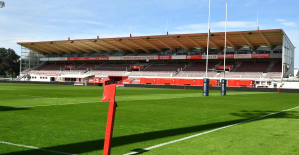The hope came prematurely: “Communists capitulate” was the headline of WELT on October 31, 1956 and added in the same font size: “Elections in Hungary”. Those in power in Budapest accepted the demands of the insurgents. "In a dramatic radio speech, Prime Minister Imre Nagy pledged free elections, the formation of a coalition government modeled on Hungary's first non-communist post-war government, the immediate withdrawal of Soviet troops from Budapest and an early withdrawal from all of Hungary, and the reestablishment of the old democratic parties."
WELT continued: "The victory of the Hungarian people's revolution is given additional security by a statement by the Soviet government on Tuesday evening, which states that the continued presence of Soviet troops in Hungary 'can only serve as a reason for a greater deterioration in the situation'. "
Imre Nagy never found out about this WELT article. He probably would have been more careful, too, because he knew what tricks and deceptions the Russians on the one hand and the Communists on the other were capable of. For many years he had himself been a staunch executor of Marxism-Leninism and, moreover, once he understood the nature of that ideology, he had come into contact with Russian imperialist ruthlessness.
Born into a peasant family in 1896, Nagy was drafted into the Austro-Hungarian army in December 1914 after training as a locksmith. Wounded in the leg in the Third Battle of the Isonzo, he was trained as a machine gunner, but was taken prisoner by the Russians during the Brusilov offensive of the Tsarist army on July 29, 1916. Via Kyiv and Ryazan he was taken by train to the Berezovka camp on Lake Baikal in Siberia.
Here Imre Nagy became acquainted with Marxist ideas. In early 1918 he joined the Communist Party of Foreign Workers of Siberia, a subgroup of the Bolsheviks. From February to September 1918 he fought in the Red Army in the Russian Civil War, but was then captured by soldiers of the Czechoslovak Legion. Nagy was able to flee and went into hiding in “white” areas, that is, areas temporarily freed from Bolshevism. When the Red Army pushed back the anti-Bolshevik troops, Nagy joined the Cheka, the Lenin Party's secret police.
Now a regular member of the Bolsheviks, he was trained as a professional revolutionary and sent home in the spring of 1921 to prepare a communist overthrow. Nagy was imprisoned for a good two months in 1927 for his left-wing activities, which were banned under Admiral Miklós Horthy's regime, but was then released. His record as a revolutionary was clearly negative.
Nevertheless, he went to Moscow in 1929/30 and spent the following years working at the (Leninist-oriented) "International Agricultural Institute", for the Hungarian department of the Comintern and for the NKVD, as the Cheka was now known. During the Great Stalin Terror from 1936 to 1939, Nagy is said to have denounced more than 200 comrades, most of whom were murdered.
After the conquest of Hungary by the Red Army (only Hungarian communists understood it as “liberation”), Nagy returned to Budapest and became Minister of Agriculture in the interim government of Béla Miklós, of course on behalf of the Hungarian Communist Party. In this capacity, he pushed ahead with land reform, a central goal of all Moscow-bound communists. The transitional government soon collapsed and was replaced by a new, more communist-dominated cabinet led by Zoltán Tildy; Nagy became Minister of the Interior and was involved in the expulsion of ethnic Germans from Hungary.
His career on party tickets continued unabated: from 1947 to 1949 he was Speaker of the Hungarian National Assembly, a largely ceremonial position. In 1951, Nagy, along with the rest of the Hungarian Politburo, signed the arrest warrant for his successor as interior minister, the Stalinist János Kádár. He was then tortured and sentenced to life imprisonment in a show trial.
After Stalin's death, on June 13, 1953, Nagy took over the position of Prime Minister of Hungary. He promoted a "new course" that would grant the subjects of the communist regime at least a little more freedom. But in the course of the ongoing conflicts in the Moscow Politburo, he fell out of favor. On April 18, 1955 he lost the post of Chairman of the Council of Ministers and also all party functions and membership.
The situation apparently changed in February 1956 with Nikita Khrushchev's secret speech at the XX. Party Congress of the CPSU, in which he condemned Stalin's "cult of personality" and thus the Stalinist system of rule. This supposed loosening of the reins led to the workers' uprising in Poznań in July. The anti-communists in Hungary also had hopes.
In order to keep the reins in hand, the Hungarian Communist Party reinstated Nagy on October 13, 1956. But he was reluctant to side with the insurgents. It was only on October 24 that he agreed to resume the post of prime minister. In the next few days, Imre Nagy became the face of the anti-Soviet popular uprising - the dynamics of events led to this.
On October 28, a first attack by Soviet and Hungarian-Stalinist forces failed, and Nagy negotiated an armistice. In radio speeches he represented the demand for the withdrawal of all foreign troops from Hungary. Apparently the Soviets, including the Moscow ambassador in Budapest Yuri Andropov, agreed. Two days later, Nagy then announced the re-admission of parties and free elections, which WELT immediately reported.
But the joy about it turned out to be premature. The master in the Kremlin, Nikita Khrushchev, appointed János Kádár as the new CP chief on November 2nd and ordered the attack on Budapest and cities in western Hungary on November 4th, the "Operation Whirlwind". Nagy responded with a dramatic speech to the world but, to minimize damage, ordered the Hungarian army not to oppose the occupiers. The popular uprising had failed, crushed by tanks on Moscow's orders.
Personally, Nagy fled to the Yugoslav Embassy, where he and many of his supporters were given refuge. János Kádár promised them a safe passage in writing - and immediately broke this promise when Nagy left the Yugoslav embassy on November 22nd. He was deported to Romania.
Two years later, after Nagy had been handed over to Hungarians loyal to Kádár, the trial took place, the result of which was clear from the start: the death penalty. On June 16, 1958, Imre Nagy was hanged in Budapest Central Prison. Exactly 31 years later to the day, in the looming Peaceful Revolution, Nagy's remains were exhumed and solemnly buried in a grave of honor. 200,000 people made the ceremony the largest anti-communist and anti-Soviet demonstration since 1956.
János Kádár, who ruled Hungary until 1988, tried with all his might to prevent Nagy's rehabilitation. He died on the same July 6, 1989, when his opponent's death sentence was officially declared illegal. As far as is known, the 77-year-old, who was seriously ill with cancer, had found out about it.
You can also find "World History" on Facebook. We are happy about a like.

 United States: divided on the question of presidential immunity, the Supreme Court offers respite to Trump
United States: divided on the question of presidential immunity, the Supreme Court offers respite to Trump Maurizio Molinari: “the Scurati affair, a European injury”
Maurizio Molinari: “the Scurati affair, a European injury” Hamas-Israel war: US begins construction of pier in Gaza
Hamas-Israel war: US begins construction of pier in Gaza Israel prepares to attack Rafah
Israel prepares to attack Rafah Spain is the country in the European Union with the most overqualified workers for their jobs
Spain is the country in the European Union with the most overqualified workers for their jobs Parvovirus alert, the “fifth disease” of children which has already caused the death of five babies in 2024
Parvovirus alert, the “fifth disease” of children which has already caused the death of five babies in 2024 Colorectal cancer: what to watch out for in those under 50
Colorectal cancer: what to watch out for in those under 50 H5N1 virus: traces detected in pasteurized milk in the United States
H5N1 virus: traces detected in pasteurized milk in the United States Private clinics announce a strike with “total suspension” of their activities, including emergencies, from June 3 to 5
Private clinics announce a strike with “total suspension” of their activities, including emergencies, from June 3 to 5 The Lagardère group wants to accentuate “synergies” with Vivendi, its new owner
The Lagardère group wants to accentuate “synergies” with Vivendi, its new owner The iconic tennis video game “Top Spin” returns after 13 years of absence
The iconic tennis video game “Top Spin” returns after 13 years of absence Three Stellantis automobile factories shut down due to supplier strike
Three Stellantis automobile factories shut down due to supplier strike A pre-Roman necropolis discovered in Italy during archaeological excavations
A pre-Roman necropolis discovered in Italy during archaeological excavations Searches in Guadeloupe for an investigation into the memorial dedicated to the history of slavery
Searches in Guadeloupe for an investigation into the memorial dedicated to the history of slavery Aya Nakamura in Olympic form a few hours before the Flames ceremony
Aya Nakamura in Olympic form a few hours before the Flames ceremony Psychiatrist Raphaël Gaillard elected to the French Academy
Psychiatrist Raphaël Gaillard elected to the French Academy Skoda Kodiaq 2024: a 'beast' plug-in hybrid SUV
Skoda Kodiaq 2024: a 'beast' plug-in hybrid SUV Tesla launches a new Model Y with 600 km of autonomy at a "more accessible price"
Tesla launches a new Model Y with 600 km of autonomy at a "more accessible price" The 10 best-selling cars in March 2024 in Spain: sales fall due to Easter
The 10 best-selling cars in March 2024 in Spain: sales fall due to Easter A private jet company buys more than 100 flying cars
A private jet company buys more than 100 flying cars This is how housing prices have changed in Spain in the last decade
This is how housing prices have changed in Spain in the last decade The home mortgage firm drops 10% in January and interest soars to 3.46%
The home mortgage firm drops 10% in January and interest soars to 3.46% The jewel of the Rocío de Nagüeles urbanization: a dream villa in Marbella
The jewel of the Rocío de Nagüeles urbanization: a dream villa in Marbella Rental prices grow by 7.3% in February: where does it go up and where does it go down?
Rental prices grow by 7.3% in February: where does it go up and where does it go down? Even on a mission for NATO, the Charles-de-Gaulle remains under French control, Lecornu responds to Mélenchon
Even on a mission for NATO, the Charles-de-Gaulle remains under French control, Lecornu responds to Mélenchon “Deadly Europe”, “economic decline”, immigration… What to remember from Emmanuel Macron’s speech at the Sorbonne
“Deadly Europe”, “economic decline”, immigration… What to remember from Emmanuel Macron’s speech at the Sorbonne Sale of Biogaran: The Republicans write to Emmanuel Macron
Sale of Biogaran: The Republicans write to Emmanuel Macron Europeans: “All those who claim that we don’t need Europe are liars”, criticizes Bayrou
Europeans: “All those who claim that we don’t need Europe are liars”, criticizes Bayrou These French cities that will boycott the World Cup in Qatar
These French cities that will boycott the World Cup in Qatar Archery: everything you need to know about the sport
Archery: everything you need to know about the sport Handball: “We collapsed”, regrets Nikola Karabatic after PSG-Barcelona
Handball: “We collapsed”, regrets Nikola Karabatic after PSG-Barcelona Tennis: smash, drop shot, slide... Nadal's best points for his return to Madrid (video)
Tennis: smash, drop shot, slide... Nadal's best points for his return to Madrid (video) Pro D2: Biarritz wins a significant success in Agen and takes another step towards maintaining
Pro D2: Biarritz wins a significant success in Agen and takes another step towards maintaining


















